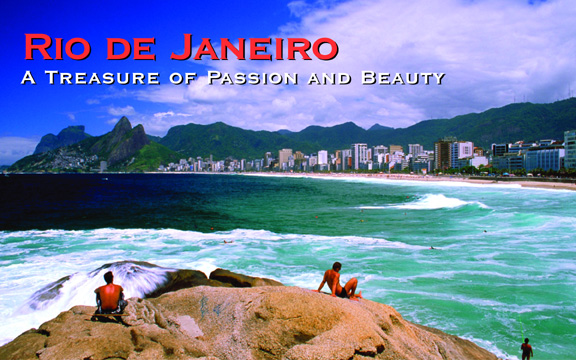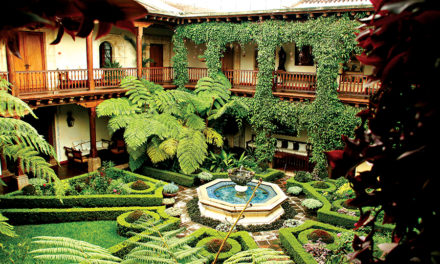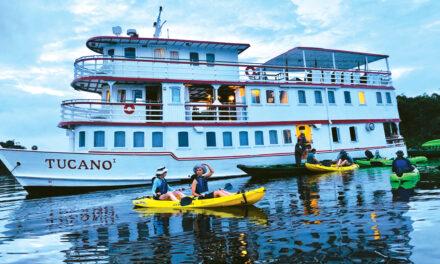Rio de Janeiro
A Treasure of Passion and Beauty
Published in the Fall 2005 Issue of Canadian World Traveller
Text: By Ron Paquet (rpaquet@bulzi.ca)
Photos: Ron Paquet & courtesy of the Brazil Tourism Office (www.braziltourism.org)
 My Varig Airlines Boeing 777 flew under the clouds revealing the majestic escarpment, sweeping valleys, and long sandy beaches of Rio de Janeiro. Next came Sugar Loaf Mountain, then the imposing statue of Christ the Redeemer soaring atop Corcovado Peak. I knew there and then that I had to get closer and embrace all of Rio’s unfolding charms.
My Varig Airlines Boeing 777 flew under the clouds revealing the majestic escarpment, sweeping valleys, and long sandy beaches of Rio de Janeiro. Next came Sugar Loaf Mountain, then the imposing statue of Christ the Redeemer soaring atop Corcovado Peak. I knew there and then that I had to get closer and embrace all of Rio’s unfolding charms.
With a population of some 12 million people spread out over some 1,255 kilometres, Rio is less dense and congested and has more green spaces than similarly sized world cities such as London, Beijing and Chicago.
Rio’s Favellas
A mere seven blocks away from the Atlantic Ocean, some 75 favellas (local shanty towns) surround much of the city. These self-built clusters of modest homes are perched on the lush hillsides that overlook the city centre.
The population in favellas grows whenever new migrants settle on a patch of land and begin the slow process of building their basic concrete block homes. Once they have lived there for over five years, the land becomes theirs. Local associations are elected to run the favellas by their mostly lower-income residents.
On one occasion, I saw several uniformed grade school students being driven along in SUVs and luxury cars. They had just left their gated private school, located just a few hundred metres from one of the favellas, on their way home to their secure compounds below the hills of Rio.
While some favella dwellers freelance as beach merchants, pushing heavily loaded carts of lawn chairs and parasols along the boulevards, many others work in the service and tourism industry.
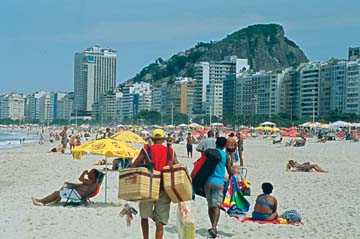 Surprisingly there is little violence in the city and on the beaches although the occasional hold-up has been reported.
Surprisingly there is little violence in the city and on the beaches although the occasional hold-up has been reported.
Prior to my trip many warned me that Rio is a very dangerous and violence-prone city not to be visited. This is far from the truth, as I did not witness or hear of any nefarious activity, day or night, and the beaches are well patrolled by police with mini-stations positioned at every two blocks.
If you are really nervous, map out your walking course on the well-lit streets facing the beaches and take taxis clearly identified as legitimate. If you’re not sure, ask the helpful staff of your hotel or at bars and restaurants. However, the best way to experience the Rio way of life is to relax and dive right in.
Beyond the postcard description, the legendary Copacabana Beach makes an exceptional first stop upon landing in Rio. The sweet scent of coconut suntan lotion fills the air as you meander across the spotlessly white, well-groomed beaches. A dazzling array of woman in thong bikinis and hunky guys in knee-high shorts fills the entire beach.
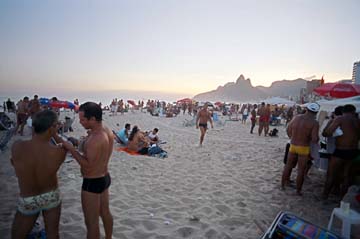 The Cariocas
The Cariocas
Rio is a lifestyle and the cultural and social capital of Brazil, while the larger Sao Paulo is not! Like Toronto, Sao Paulo is home to the high-powered Brazilian business community.
It is a highly developed, massive industrial city, and serves as the economic centre of Brazil. However, almost everyone agrees that Rio is definitely the Brazilian city for fun!
Each day Rio sings and dances till the wee hours of the morning and as welcome visitors, we are treated to the exceptionally warm hospitality of the Cariocas (the local Rio residents). Although they enjoy their work, playtime is very important to them as witnessed by the throngs of Cariocas filling the bars and restaurants and dancing the samba every night of the week.
During the day and early evening, people of all ages (some with their dogs) jog or bike on the pedestrian path alongside Atlântica Avenue. The pathway runs pass the regal Copacabana Hotel, a landmark building which has played host to kings and queens, as well as members of the international jet-set. An extensive photo exhibition of its illustrious former guests is on display on the second floor.
The Beaches
Copacabana beach, now frequented mostly by the working class, has lost much of its allure to neighbouring Ipanema beach. Ipanema now draws those legendary bathing beauties, as well as professional beach volleyball teams practicing for the next Olympics.
 Leblon and Bahia are two other beach areas favoured by tourists and the higher-income residents of Rio. We stayed at the luxurious Sheraton Barra Hotel overlooking the beach in Barra da Tijuca, a pleasant 20-minute drive from the centre of Rio.
Leblon and Bahia are two other beach areas favoured by tourists and the higher-income residents of Rio. We stayed at the luxurious Sheraton Barra Hotel overlooking the beach in Barra da Tijuca, a pleasant 20-minute drive from the centre of Rio.
Close to the end of the week, the hotel bar proved to be quite a popular place for tourists and locals alike. The bar was filled with those legendary tanned Brazilian beauties, the vast majority of them tall and stunning. However, if you don’t speak Portuguese, you might have difficulty communicating, as most of them spoke little English. Fortunately for me, one of my Washington journalist friends on the trip spoke Portuguese and acted as a willing interpreter.
Besides the attractiveness and friendliness of its inhabitants, the sights and sounds of Rio are simply amazing. Combine the joie de vivre and spontaneity of Montrealers, the ambiance of New Orleans and the most beautiful beaches in the world and the result is Cidade Maravilhosa (The Marvellous City, as Rio is justly called).
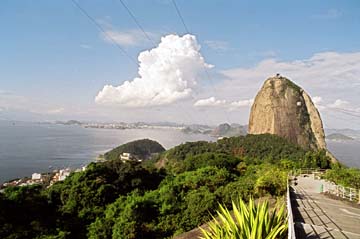 A Birds-eye View
A Birds-eye View
A trip to the top of the 396-metre high Sugar Loaf Mountain (Pão de Açúcar), which was featured in the James Bond movie Moonraker, affords a birds-eye view of Rio. A two-stage, 75-person cable car slowly crosses Rio’s valley, some 200 metres below, to its first stop at Morro da Urca.
The exhilarating ride comes to an end 15 minutes later atop Sugar Loaf. What an astounding view of the planet’s most beautiful city!
Behind Sugar Loaf, Corcovado Peak rises majestically to 710 metres above sea level. A small, three-car cog train called a bonde pulls you up a very steep incline. Its late afternoon and a thick fog settles down upon the tourists and envelopes the 30-metre tall Christ the Redeemer (Cristo Redentor), creating a mystical experience that causes many to reflect on their own spiritual beliefs.
 Rio Carnival
Rio Carnival
The ultimate Brazilian experience however is the Carnival that takes place four days before Lent in February.
A spectacular parade of beauty and pageantry (float teams prepare for months and dancers practice year-round), the parade carves its way through the streets of Rio and passes the judges at the Sambodromo reviewing stand close to Maracanã, the world’s largest soccer stadium.
The stadium was inaugurated in June of 1950. Since then, legends such as Edson Arantesdo Nascimento (Pele), have played for Brazil against international teams in front of record crowds of 200,000.
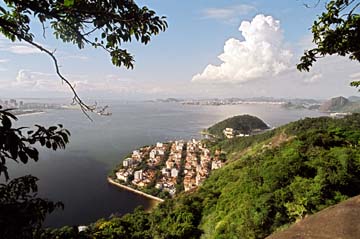 We had an opportunity to visit a small leafy bohemian barrio of quaint little apartments and attractive homes, including the best examples of Rio’s 19-century mansions and walled gardens, located on the hills of Santa Teresa overlooking the city and Guanabara bay below.
We had an opportunity to visit a small leafy bohemian barrio of quaint little apartments and attractive homes, including the best examples of Rio’s 19-century mansions and walled gardens, located on the hills of Santa Teresa overlooking the city and Guanabara bay below.
Rio’s Soho is home to many artists who can be visited by tourists. While there, it’s also worth making a short visit to the Chácara do Céu Museum (Little house in the Sky), which provides a good perspective into Brazil’s colourful history.
Finally if you are seduced by fine jewellery, you must visit the free permanent exhibitions of the H. Sterns jewellery collections, including rare mineral specimens and cut tourmalines.
This and so much more is Rio. Prepare yourself to be totally seduced by its beauty and charm! And don’t forget the 2007 Pan American Games, scheduled to take place in Rio.
For More Info:
Contact the Brazil Tourism Office (Canada & USA)
Toll-free.: 1-800-727-2945
www.braziltourism.org
.

